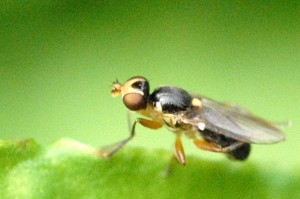If you have ever been biking or walking outside during the summer in Texas, then you probably have experienced running into what appears to be “clouds” or groups of tiny gnats. Unexpectedly, you get them all in your mouth, hair, nose and eyes, and no matter what amount of coughing, swatting, or waving of the arms you do, a few blocks later you receive another face-full of gnats. At least that is what occurred to me for the past month. On my way to school each morning I would run into on average 3 clouds of gnats a day. Why they seemed to gravitate towards people’s heads, and why there were so many of them in the same location everyday, I did not know. It wasn’t until I went on my first insect biology field trip that I learned more about them.
Earlier this month, Dr. Solomon’s Insect Biology lab went to Spring Creek Greenway to collect and study insects. One of the first observations I made at the site was a very large cloud of tiny flies. This cloud of insects was much larger than those in the city, and amazingly, they moved in unison. Dr. Solomon informed our class that these insects were most likely “eye gnats” of the order Diptera and genus Liohippelates; and the clouds they formed were called leks.
Male eye gnats, which are about 1/16th to 1/8th of an inch in size, gather together in large groups to attract female mates. Because they are so small, finding a mate on their own would be difficult. In order to further increase their visibility, these gnats often hover over tall objects, which is called “hilltopping”. In leks the males impress females by rapidly flying in perfect formation. On the down side, these leks make easy targets for predators. This is why oftentimes at the park I noticed dragonflies flying through and around these leks taking bites from the group.
Eye gnats are true flies; they have only two wings and two halteres. Their halteres support them in making quick turns and stops while flying in unison. There can be hundreds and even thousands of eye gnats in one lek. One reason for their large numbers is due to their fast generation times. Eye gnat eggs hatch within 2 weeks and become sexually mature in about 3 weeks. These gnats undergo holometabolous metamorphosis. Eggs are laid in shallow layers of soil or and once they hatch, the larvae feed on decayed plant matter. Eye gnats get their name from the fact that as adults, they drink the moisture from animals’ eyes and sweat. This also explains why they gather around people’s heads. Although eye gnats are mostly harmless, one species, Lioppelates flavipes, is known to transmit pink eye through a bacteria they carry inside of their bodies. Other species can transmit yaws, a skin disease common in South America.
Eye gnats are interesting flies that are greater together in number. The next time I find my head in a cloud of gnats I will remember that the little guys are only trying to find a mate.

